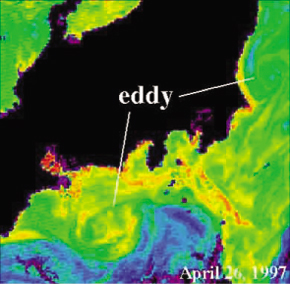Primary Production based on Eddy of the Kuroshio Front - influence of the Kuroshio flow for cathes of yellowtail and juvenile of sardine -
Disturbance by low pressure based on front wave occurs in area of the Kuroshio front (Figure 1). This phenomenon provides high density of nutrients for phytoplankton from below the photic zone, and rise the productivity of phyto and zooplanktons significantly. On the other hand, the offshore of the Kuroshio is one of the low productivity areas, which are not good for fish larvae survival. Then, how they manage these disadvantage condition? We consider spawning behavior of adults and larvae behavior to illuminate how they gain required energy.
Numerical simulation and observation of Enshu-Nada gave the sestimate of amount of the primary production of an eddy, 4x104tons. Considering the eddy influence to whole coastal area of Enshu-Nada, the primary production would be 40gCm-2y-1 (Figure 2). The value matches to the estimates of the Gulf stream in Atlantic ocean. Thus, western boundary currents of Pacific and Atlantic would bring the biological production of similar scale. On the other hand, estimates form past resaerches indicate its 1/3 of the primary production in Enshu-Nada was brough by the eddy. To consider primary production in coastal area, the eddy influences is not negligible.
In the eddy area, vertical mixing occurs soon after its emergence and concentration of nitrate nitrogen became uniform at 30m and 50m depth. As time goes by, the nitrate nitrogen concentration drops and chrolophyl concentration increases. Following the phenomenon, density of copepod nauplii increases, and eggs and larva of japanese anchovi distribute where the maximus density of copepod nauplii (Figure 3). Thus, eddy emergence have an influence not only primary production, but also to secondary production. Promary production as food source of larvae and juvenile and their survival depends on vertical transfer of nutirients in the Kuroshio front area, and adults actively choose the spawning grounds for better survival of larvae and juvenile.
 |
 |
| Figure 1. Ocean Color Image of Eddy by Satelite | |
 | |
| Figure 2. Path of Biological Production at the Kuroshio Front | Figure 3. Production of Lower Trophic Level at Eddy and Distribution of Eggs and Larvae |
References
- 木村伸吾.(2004) 黒潮フロント域の低次生物生産過程.海流と生物資源,杉本隆成編著,成山堂書店,pp268,194-200.
- Okazaki, Y., Nakata, H., Kimura, S. and Kasai, A. (2003) Offshore entrainment of anchovy larvae and its implication for their survival in a frontal region of the Kuroshio. Marine Ecology Progress Series, 248, 237-244.
- Kasai, A., Kimura, S., Nakata, H. and Okazaki, Y. (2002) Entrainment of coastal water into a frontal eddy of the Kuroshio and its biological significance. Journal of Marine Systems, 37, 185-198.
- Kimura, S. and Sugimoto, T. (2001) Biological productivity and behavior in an eddy in the lee of isolated island on the basis of research using ADCP and fluorometers.
- Proceedings on “International symposium on advanced techniques of sampling gear and acoustical surveys for estimation of fish abundance and behavior” (ACOUSTGEAR2000), 180-190.
- Kimura, S., Nakata, H. and Okazaki, Y. (2000) Biological production in meso-scale eddies caused by frontal disturbances of the Kuroshio Extension. ICES Journal of Marine Science, 57, 133-142.
- Kimura, S. and Sugimoto, T. (2000) Two processes by which short-period fluctuations in the meander of the Kuroshio affect its countercurrent. Deep-Sea Research, 47, 745-754.
- Kimura, S., Nakata, H., Okazaki, Y. and Sugimoto, T. (1999) Biological production process associated with frontal disturbance of the Kuroshio and Kuroshio Extension. Bulletin of Tohoku National Fisheries Research Institute, 62, 207-213.
- 木村伸吾.(1999) 黒潮フロント域における物理過程と生物生産過程.月刊海洋,31,197-200.
- Kimura, S., Kasai, A., Nakata, H., Sugimoto, T., Simpson, J.H. and Cheok, J.V.S. (1997) Biological productivity of meso-scale eddies caused by frontal disturbances in the Kuroshio. ICES Journal of Marine Science, 54, 179-192.
- 木村伸吾.(1997) 黒潮フロント域における基礎生産過程.海と空,73,9-14.
- Kimura, S., Choo, S.H. and Sugimoto, T. (1994) Characteristics of the eddy caused by Izu-Oshima Island and the Kuroshio Branch Current in Sagami Bay, Japan. Journal of Oceanography, 50, 373-389.
- 笠井亮秀・木村伸吾・杉本隆成.(1994) 熊野灘・遠州灘への黒潮系暖水の流入.月刊海洋,26,703-707.
- Kimura, S. and Sugimoto, T. (1993) Short-period fluctuations in meander of the Kuroshio’s path off Cape Shiono Misaki. Journal of Geophysical Research, 98, 2407-2418.
- Kasai, A., Kimura, S. and Sugimoto, T. (1993) Warm water intrusion from the Kuroshio into the coastal areas south of Japan. Journal of Oceanography, 49, 607-624.
- 木村伸吾・杉本隆成.(1990) 熊野灘・遠州灘沿岸域への黒潮系暖水の流入過程.水産海洋学会誌,54,19-31.
- 木村伸吾・杉本隆成.(1988) 遠州灘沿岸域における短期漁海況変動.水産海洋学会誌,52,221-228.
- Kimura, S. and Sugimoto, T. (1987) Short period fluctuations in oceanographic and fishing conditions in the coastal area of Kumano-nada Sea. Nippon Suisan Gakkaishi, 53, 585-593.
- 木村伸吾・小林雅人・杉本隆成.(1987) 熊野灘の短期漁海況変動_定置網漁況に影響を及ぼす沖合および沿岸の海況変動.海洋科学,19,429-433.


